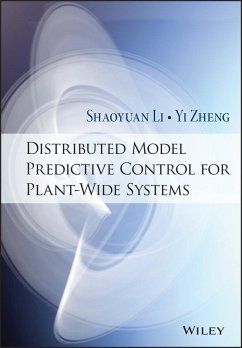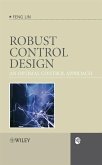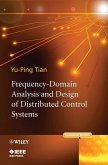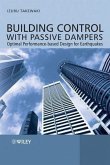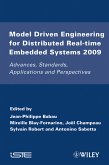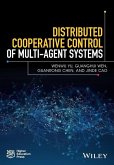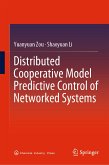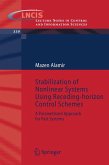

Alle Infos zum eBook verschenken

- Format: PDF
- Merkliste
- Auf die Merkliste
- Bewerten Bewerten
- Teilen
- Produkt teilen
- Produkterinnerung
- Produkterinnerung

Hier können Sie sich einloggen

Bitte loggen Sie sich zunächst in Ihr Kundenkonto ein oder registrieren Sie sich bei bücher.de, um das eBook-Abo tolino select nutzen zu können.
DISTRIBUTED MODEL PREDICTIVE CONTROL FOR PLANT-WIDE SYSTEMS DISTRIBUTED MODEL PREDICTIVE CONTROL FOR PLANT-WIDE SYSTEMS In this book, experienced researchers gave a thorough explanation of distributed model predictive control (DMPC): its basic concepts, technologies, and implementation in plant-wide systems. Known for its error tolerance, high flexibility, and good dynamic performance, DMPC is a popular topic in the control field and is widely applied in many industries. To efficiently design DMPC systems, readers will be introduced to several categories of coordinated DMPCs, which are…mehr
- Geräte: PC
- mit Kopierschutz
- eBook Hilfe
- Größe: 8.99MB
![Robust Control Design (eBook, PDF) Robust Control Design (eBook, PDF)]() Feng LinRobust Control Design (eBook, PDF)121,99 €
Feng LinRobust Control Design (eBook, PDF)121,99 €![Frequency-Domain Analysis and Design of Distributed Control Systems (eBook, PDF) Frequency-Domain Analysis and Design of Distributed Control Systems (eBook, PDF)]() Yu-Ping TianFrequency-Domain Analysis and Design of Distributed Control Systems (eBook, PDF)111,99 €
Yu-Ping TianFrequency-Domain Analysis and Design of Distributed Control Systems (eBook, PDF)111,99 €![Building Control with Passive Dampers (eBook, PDF) Building Control with Passive Dampers (eBook, PDF)]() Izuru TakewakiBuilding Control with Passive Dampers (eBook, PDF)139,99 €
Izuru TakewakiBuilding Control with Passive Dampers (eBook, PDF)139,99 €![Model Driven Engineering for Distributed Real-Time Embedded Systems 2009 (eBook, PDF) Model Driven Engineering for Distributed Real-Time Embedded Systems 2009 (eBook, PDF)]() Model Driven Engineering for Distributed Real-Time Embedded Systems 2009 (eBook, PDF)139,99 €
Model Driven Engineering for Distributed Real-Time Embedded Systems 2009 (eBook, PDF)139,99 €![Distributed Cooperative Control of Multi-agent Systems (eBook, PDF) Distributed Cooperative Control of Multi-agent Systems (eBook, PDF)]() Wenwu YuDistributed Cooperative Control of Multi-agent Systems (eBook, PDF)111,99 €
Wenwu YuDistributed Cooperative Control of Multi-agent Systems (eBook, PDF)111,99 €![Distributed Cooperative Model Predictive Control of Networked Systems (eBook, PDF) Distributed Cooperative Model Predictive Control of Networked Systems (eBook, PDF)]() Yuanyuan ZouDistributed Cooperative Model Predictive Control of Networked Systems (eBook, PDF)73,95 €
Yuanyuan ZouDistributed Cooperative Model Predictive Control of Networked Systems (eBook, PDF)73,95 €![Stabilization of Nonlinear Systems Using Receding-horizon Control Schemes (eBook, PDF) Stabilization of Nonlinear Systems Using Receding-horizon Control Schemes (eBook, PDF)]() Mazen AlamirStabilization of Nonlinear Systems Using Receding-horizon Control Schemes (eBook, PDF)73,95 €
Mazen AlamirStabilization of Nonlinear Systems Using Receding-horizon Control Schemes (eBook, PDF)73,95 €-
-
-
Dieser Download kann aus rechtlichen Gründen nur mit Rechnungsadresse in A, B, BG, CY, CZ, D, DK, EW, E, FIN, F, GR, HR, H, IRL, I, LT, L, LR, M, NL, PL, P, R, S, SLO, SK ausgeliefert werden.
- Produktdetails
- Verlag: John Wiley & Sons
- Seitenzahl: 328
- Erscheinungstermin: 24. Juli 2015
- Englisch
- ISBN-13: 9781118921586
- Artikelnr.: 43446556
- Verlag: John Wiley & Sons
- Seitenzahl: 328
- Erscheinungstermin: 24. Juli 2015
- Englisch
- ISBN-13: 9781118921586
- Artikelnr.: 43446556
- Herstellerkennzeichnung Die Herstellerinformationen sind derzeit nicht verfügbar.
About the Authors xv
Acknowledgement xvii
List of Figures xix
List of Tables xxiii
1 Introduction 1
1.1 Plant-Wide System 1
1.2 Control System Structure of the Plant-Wide System 3
1.2.1 Centralized Control 4
1.2.2 Decentralized Control and Hierarchical Coordinated Decentralized
Control 5
1.2.3 Distributed Control 6
1.3 Predictive Control 8
1.3.1 What is Predictive Control 8
1.3.2 Advantage of Predictive Control 9
1.4 Distributed Predictive Control 9
1.4.1 Why Distributed Predictive Control 9
1.4.2 What is Distributed Predictive Control 10
1.4.3 Advantage of Distributed Predictive Control 10
1.4.4 Classification of DMPC 11
1.5 About this Book 13
Part I FOUNDATION
2 Model Predictive Control 19
2.1 Introduction 19
2.2 Dynamic Matrix Control 20
2.2.1 Step Response Model 20
2.2.2 Prediction 21
2.2.3 Optimization 22
2.2.4 Feedback Correction 23
2.2.5 DMC with Constraint 24
2.3 Predictive Control with the State Space Model 26
2.3.1 System Model 27
2.3.2 Performance Index 28
2.3.3 Prediction 28
2.3.4 Closed-Loop Solution 30
2.3.5 State Space MPC with Constraint 31
2.4 Dual Mode Predictive Control 33
2.4.1 Invariant Region 33
2.4.2 MPC Formulation 34
2.4.3 Algorithms 35
2.4.4 Feasibility and Stability 36
2.5 Conclusion 37
3 Control Structure of Distributed MPC 39
3.1 Introduction 39
3.2 Centralized MPC 40
3.3 Single-Layer Distributed MPC 41
3.4 Hierarchical Distributed MPC 42
3.5 Example of the Hierarchical DMPC Structure 43
3.6 Conclusion 45
4 Structure Model and System Decomposition 47
4.1 Introduction 47
4.2 System Mathematic Model 48
4.3 Structure Model and Structure Controllability 50
4.3.1 Structure Model 50
4.3.2 Function of the Structure Model in System Decomposition 51
4.3.3 Input-Output Accessibility 53
4.3.4 General Rank of the Structure Matrix 56
4.3.5 Structure Controllability 56
4.4 Related Gain Array Decomposition 58
4.4.1 RGA Definition 59
4.4.2 RGA Interpretation 60
4.4.3 Pairing Rules 61
4.5 Conclusion 63
Part II UNCONSTRAINED DISTRIBUTED PREDICTIVE CONTROL
5 Local Cost Optimization-based Distributed Model Predictive Control 67
5.1 Introduction 67
5.2 Local Cost Optimization-based Distributed Predictive Control 68
5.2.1 Problem Description 68
5.2.2 DMPC Formulation 69
5.2.3 Closed-loop Solution 72
5.2.4 Stability Analysis 79
5.2.5 Simulation Results 79
5.3 Distributed MPC Strategy Based on Nash Optimality 82
5.3.1 Formulation 83
5.3.2 Algorithm 86
5.3.3 Computational Convergence for Linear Systems 86
5.3.4 Nominal Stability of Distributed Model Predictive Control System 88
5.3.5 Performance Analysis with Single-step Horizon Control Under
Communication Failure 89
5.3.6 Simulation Results 94
5.4 Conclusion 99
Appendix 99
Appendix A. QP problem transformation 99
Appendix B. Proof of Theorem 5.1 100
6 Cooperative Distributed Predictive Control 103
6.1 Introduction 103
6.2 Noniterative Cooperative DMPC 104
6.2.1 System Description 104
6.2.2 Formulation 104
6.2.3 Closed-Form Solution 107
6.2.4 Stability and Performance Analysis 109
6.2.5 Example 113
6.3 Distributed Predictive Control based on Pareto Optimality 114
6.3.1 Formulation 118
6.3.2 Algorithm 119
6.3.3 The DMPC Algorithm Based on Plant-Wide Optimality 119
6.3.4 The Convergence Analysis of the Algorithm 121
6.4 Simulation 121
6.5 Conclusions 123
7 Networked Distributed Predictive Control with Information Structure
Constraints 125
7.1 Introduction 125
7.2 Noniterative Networked DMPC 126
7.2.1 Problem Description 126
7.2.2 DMPC Formulation 127
7.2.3 Closed-Form Solution 132
7.2.4 Stability Analysis 135
7.2.5 Analysis of Performance 135
7.2.6 Numerical Validation 137
7.3 Networked DMPC with Iterative Algorithm 144
7.3.1 Problem Description 144
7.3.2 DMPC Formulation 145
7.3.3 Networked MPC Algorithm 147
7.3.4 Convergence and Optimality Analysis for Networked 150
7.3.5 Nominal Stability Analysis for Distributed Control Systems 152
7.3.6 Simulation Study 153
7.4 Conclusion 159
Appendix 159
Appendix A. Proof of Lemma 7.1 159
Appendix B. Proof of Lemma 7.2 160
Appendix C. Proof of Lemma 7.3 160
Appendix D. Proof of Theorem 7.1 161
Appendix E. Proof of Theorem 7.2 161
Appendix F. Derivation of the QP problem (7.52) 164
Part III CONSTRAINT DISTRIBUTED PREDICTIVE CONTROL
8 Local Cost Optimization Based Distributed Predictive Control with
Constraints 169
8.1 Introduction 169
8.2 Problem Description 170
8.3 Stabilizing Dual Mode Noncooperative DMPC with Input Constraints 171
8.3.1 Formulation 171
8.3.2 Algorithm Design for Resolving Each Subsystem-based Predictive
Control 176
8.4 Analysis 177
8.4.1 Recursive Feasibility of Each Subsystem-based Predictive Control 177
8.4.2 Stability Analysis of Entire Closed-loop System 183
8.5 Example 184
8.5.1 The System 184
8.5.2 Performance Comparison with the Centralized MPC 185
8.6 Conclusion 187
9 Cooperative Distributed Predictive Control with Constraints 189
9.1 Introduction 189
9.2 System Description 190
9.3 Stabilizing Cooperative DMPC with Input Constraints 191
9.3.1 Formulation 191
9.3.2 Constraint C-DMPC Algorithm 193
9.4 Analysis 194
9.4.1 Feasibility 194
9.4.2 Stability 199
9.5 Simulation 201
9.6 Conclusion 208
10 Networked Distributed Predictive Control with Inputs and Information
Structure Constraints 209
10.1 Introduction 209
10.2 Problem Description 210
10.3 Constrained N-DMPC 212
10.3.1 Formulation 212
10.3.2 Algorithm Design for Resolving Each Subsystem-based Predictive
Control 218
10.4 Analysis 219
10.4.1 Feasibility 219
10.4.2 Stability 225
10.5 Formulations Under Other Coordination Strategies 227
10.5.1 Local Cost Optimization Based DMPC 227
10.5.2 Cooperative DMPC 228
10.6 Simulation Results 229
10.6.1 The System 229
10.6.2 Performance of Closed-loop System under the N-DMPC 230
10.6.3 Performance Comparison with the Centralized MPC and the Local Cost
Optimization based MPC 231
10.7 Conclusions 236
Part IV APPLICATION
11 Hot-Rolled Strip Laminar Cooling Process with Distributed Predictive
Control 239
11.1 Introduction 239
11.2 Laminar Cooling of Hot-rolled Strip 240
11.2.1 Description 240
11.2.2 Thermodynamic Model 241
11.2.3 Problem Statement 242
11.3 Control Strategy of HSLC 244
11.3.1 State Space Model of Subsystems 244
11.3.2 Design of Extended Kalman Filter 247
11.3.3 Predictor 247
11.3.4 Local MPC Formulation 248
11.3.5 Iterative Algorithm 249
11.4 Numerical Experiment 251
11.4.1 Validation of Designed Model 251
11.4.2 Convergence of EKF 252
11.4.3 Performance of DMPC Comparing with Centralized MPC 252
11.4.4 Advantages of the Proposed DMPC Framework Comparing with the
Existing Method 253
11.5 Experimental Results 256
11.6 Conclusion 258
12 High-Speed Train Control with Distributed Predictive Control 263
12.1 Introduction 263
12.2 System Description 264
12.3 N-DMPC for High-Speed Trains 264
12.3.1 Three Types of Force 264
12.3.2 The Force Analysis of EMUs 266
12.3.3 Model of CRH2 267
12.3.4 Performance Index 271
12.3.5 Optimization Problem 272
12.4 Simulation Results 272
12.4.1 Parameters of CRH2 273
12.4.2 Simulation Matrix 273
12.4.3 Results and Some Comments 274
12.5 Conclusion 278
13 Operation Optimization of Multitype Cooling Source System Based on DMPC
279
13.1 Introduction 279
13.2 Structure of Joint Cooling System 279
13.3 Control Strategy of Joint Cooling System 280
13.3.1 Economic Optimization Strategy 281
13.3.2 Design of Distributed Model Predictive Control in Multitype Cold
Source System 283
13.4 Results and Analysis of Simulation 286
13.5 Conclusion 292
References 293
Index 299
About the Authors xv
Acknowledgement xvii
List of Figures xix
List of Tables xxiii
1 Introduction 1
1.1 Plant-Wide System 1
1.2 Control System Structure of the Plant-Wide System 3
1.2.1 Centralized Control 4
1.2.2 Decentralized Control and Hierarchical Coordinated Decentralized
Control 5
1.2.3 Distributed Control 6
1.3 Predictive Control 8
1.3.1 What is Predictive Control 8
1.3.2 Advantage of Predictive Control 9
1.4 Distributed Predictive Control 9
1.4.1 Why Distributed Predictive Control 9
1.4.2 What is Distributed Predictive Control 10
1.4.3 Advantage of Distributed Predictive Control 10
1.4.4 Classification of DMPC 11
1.5 About this Book 13
Part I FOUNDATION
2 Model Predictive Control 19
2.1 Introduction 19
2.2 Dynamic Matrix Control 20
2.2.1 Step Response Model 20
2.2.2 Prediction 21
2.2.3 Optimization 22
2.2.4 Feedback Correction 23
2.2.5 DMC with Constraint 24
2.3 Predictive Control with the State Space Model 26
2.3.1 System Model 27
2.3.2 Performance Index 28
2.3.3 Prediction 28
2.3.4 Closed-Loop Solution 30
2.3.5 State Space MPC with Constraint 31
2.4 Dual Mode Predictive Control 33
2.4.1 Invariant Region 33
2.4.2 MPC Formulation 34
2.4.3 Algorithms 35
2.4.4 Feasibility and Stability 36
2.5 Conclusion 37
3 Control Structure of Distributed MPC 39
3.1 Introduction 39
3.2 Centralized MPC 40
3.3 Single-Layer Distributed MPC 41
3.4 Hierarchical Distributed MPC 42
3.5 Example of the Hierarchical DMPC Structure 43
3.6 Conclusion 45
4 Structure Model and System Decomposition 47
4.1 Introduction 47
4.2 System Mathematic Model 48
4.3 Structure Model and Structure Controllability 50
4.3.1 Structure Model 50
4.3.2 Function of the Structure Model in System Decomposition 51
4.3.3 Input-Output Accessibility 53
4.3.4 General Rank of the Structure Matrix 56
4.3.5 Structure Controllability 56
4.4 Related Gain Array Decomposition 58
4.4.1 RGA Definition 59
4.4.2 RGA Interpretation 60
4.4.3 Pairing Rules 61
4.5 Conclusion 63
Part II UNCONSTRAINED DISTRIBUTED PREDICTIVE CONTROL
5 Local Cost Optimization-based Distributed Model Predictive Control 67
5.1 Introduction 67
5.2 Local Cost Optimization-based Distributed Predictive Control 68
5.2.1 Problem Description 68
5.2.2 DMPC Formulation 69
5.2.3 Closed-loop Solution 72
5.2.4 Stability Analysis 79
5.2.5 Simulation Results 79
5.3 Distributed MPC Strategy Based on Nash Optimality 82
5.3.1 Formulation 83
5.3.2 Algorithm 86
5.3.3 Computational Convergence for Linear Systems 86
5.3.4 Nominal Stability of Distributed Model Predictive Control System 88
5.3.5 Performance Analysis with Single-step Horizon Control Under
Communication Failure 89
5.3.6 Simulation Results 94
5.4 Conclusion 99
Appendix 99
Appendix A. QP problem transformation 99
Appendix B. Proof of Theorem 5.1 100
6 Cooperative Distributed Predictive Control 103
6.1 Introduction 103
6.2 Noniterative Cooperative DMPC 104
6.2.1 System Description 104
6.2.2 Formulation 104
6.2.3 Closed-Form Solution 107
6.2.4 Stability and Performance Analysis 109
6.2.5 Example 113
6.3 Distributed Predictive Control based on Pareto Optimality 114
6.3.1 Formulation 118
6.3.2 Algorithm 119
6.3.3 The DMPC Algorithm Based on Plant-Wide Optimality 119
6.3.4 The Convergence Analysis of the Algorithm 121
6.4 Simulation 121
6.5 Conclusions 123
7 Networked Distributed Predictive Control with Information Structure
Constraints 125
7.1 Introduction 125
7.2 Noniterative Networked DMPC 126
7.2.1 Problem Description 126
7.2.2 DMPC Formulation 127
7.2.3 Closed-Form Solution 132
7.2.4 Stability Analysis 135
7.2.5 Analysis of Performance 135
7.2.6 Numerical Validation 137
7.3 Networked DMPC with Iterative Algorithm 144
7.3.1 Problem Description 144
7.3.2 DMPC Formulation 145
7.3.3 Networked MPC Algorithm 147
7.3.4 Convergence and Optimality Analysis for Networked 150
7.3.5 Nominal Stability Analysis for Distributed Control Systems 152
7.3.6 Simulation Study 153
7.4 Conclusion 159
Appendix 159
Appendix A. Proof of Lemma 7.1 159
Appendix B. Proof of Lemma 7.2 160
Appendix C. Proof of Lemma 7.3 160
Appendix D. Proof of Theorem 7.1 161
Appendix E. Proof of Theorem 7.2 161
Appendix F. Derivation of the QP problem (7.52) 164
Part III CONSTRAINT DISTRIBUTED PREDICTIVE CONTROL
8 Local Cost Optimization Based Distributed Predictive Control with
Constraints 169
8.1 Introduction 169
8.2 Problem Description 170
8.3 Stabilizing Dual Mode Noncooperative DMPC with Input Constraints 171
8.3.1 Formulation 171
8.3.2 Algorithm Design for Resolving Each Subsystem-based Predictive
Control 176
8.4 Analysis 177
8.4.1 Recursive Feasibility of Each Subsystem-based Predictive Control 177
8.4.2 Stability Analysis of Entire Closed-loop System 183
8.5 Example 184
8.5.1 The System 184
8.5.2 Performance Comparison with the Centralized MPC 185
8.6 Conclusion 187
9 Cooperative Distributed Predictive Control with Constraints 189
9.1 Introduction 189
9.2 System Description 190
9.3 Stabilizing Cooperative DMPC with Input Constraints 191
9.3.1 Formulation 191
9.3.2 Constraint C-DMPC Algorithm 193
9.4 Analysis 194
9.4.1 Feasibility 194
9.4.2 Stability 199
9.5 Simulation 201
9.6 Conclusion 208
10 Networked Distributed Predictive Control with Inputs and Information
Structure Constraints 209
10.1 Introduction 209
10.2 Problem Description 210
10.3 Constrained N-DMPC 212
10.3.1 Formulation 212
10.3.2 Algorithm Design for Resolving Each Subsystem-based Predictive
Control 218
10.4 Analysis 219
10.4.1 Feasibility 219
10.4.2 Stability 225
10.5 Formulations Under Other Coordination Strategies 227
10.5.1 Local Cost Optimization Based DMPC 227
10.5.2 Cooperative DMPC 228
10.6 Simulation Results 229
10.6.1 The System 229
10.6.2 Performance of Closed-loop System under the N-DMPC 230
10.6.3 Performance Comparison with the Centralized MPC and the Local Cost
Optimization based MPC 231
10.7 Conclusions 236
Part IV APPLICATION
11 Hot-Rolled Strip Laminar Cooling Process with Distributed Predictive
Control 239
11.1 Introduction 239
11.2 Laminar Cooling of Hot-rolled Strip 240
11.2.1 Description 240
11.2.2 Thermodynamic Model 241
11.2.3 Problem Statement 242
11.3 Control Strategy of HSLC 244
11.3.1 State Space Model of Subsystems 244
11.3.2 Design of Extended Kalman Filter 247
11.3.3 Predictor 247
11.3.4 Local MPC Formulation 248
11.3.5 Iterative Algorithm 249
11.4 Numerical Experiment 251
11.4.1 Validation of Designed Model 251
11.4.2 Convergence of EKF 252
11.4.3 Performance of DMPC Comparing with Centralized MPC 252
11.4.4 Advantages of the Proposed DMPC Framework Comparing with the
Existing Method 253
11.5 Experimental Results 256
11.6 Conclusion 258
12 High-Speed Train Control with Distributed Predictive Control 263
12.1 Introduction 263
12.2 System Description 264
12.3 N-DMPC for High-Speed Trains 264
12.3.1 Three Types of Force 264
12.3.2 The Force Analysis of EMUs 266
12.3.3 Model of CRH2 267
12.3.4 Performance Index 271
12.3.5 Optimization Problem 272
12.4 Simulation Results 272
12.4.1 Parameters of CRH2 273
12.4.2 Simulation Matrix 273
12.4.3 Results and Some Comments 274
12.5 Conclusion 278
13 Operation Optimization of Multitype Cooling Source System Based on DMPC
279
13.1 Introduction 279
13.2 Structure of Joint Cooling System 279
13.3 Control Strategy of Joint Cooling System 280
13.3.1 Economic Optimization Strategy 281
13.3.2 Design of Distributed Model Predictive Control in Multitype Cold
Source System 283
13.4 Results and Analysis of Simulation 286
13.5 Conclusion 292
References 293
Index 299
